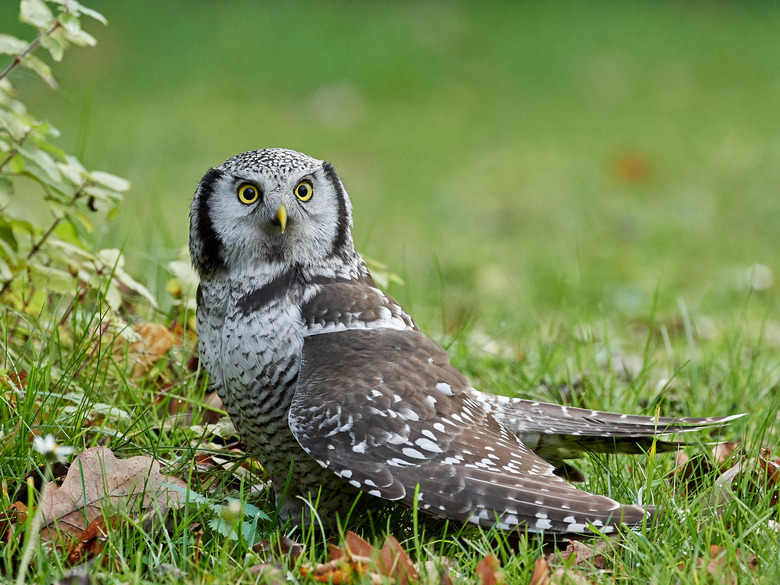Facts About Owl Pellets
There's a decent chance you've dissected an owl pellet in a science classroom or a nature center at one point or another. These "castings" offer a classic hands-on ecology lesson, providing as they do accessible, fascinating windows into the diet of the raptor that produced them.
Despite their general resemblance to scat, owl pellets are not owl poop. They are regurgitated remnants of prey, specifically the indigestible parts of the meal such as bones, fur, claws and feathers.
Facts About Owl Pellets: Formation
Facts About Owl
Pellets: Formation
Owls tend to swallow their prey whole or in large chunks. This food passes directly into the digestive tract, as owls lack the crop – a storage pouch, basically, in the esophagus – that many birds, including most diurnal raptors, possess.
The first chamber of the owl stomach, the proventriculus, begins processing the digestible portions of the prey, which then move through the second stomach chamber, the gizzard, and into the intestines.
The indigestible materials of the owl's meal, which include sharp-edged bones and teeth, could cause damage to the bird's lower digestive tract if they were allowed to pass through as owl scat. Instead, the grinding action and churning acids of the gizzard mold them into a tightly packed mass: the pellet.
Pellets typically form several hours after an owl's had its feed. Multiple prey consumed in a short time period are typically processed into a single composite pellet.
Owls aren't the only birds that produce pellets. Quite a few others do as well, including hawks. However, owl pellets tend to be larger than those ejected by hawks because owls tend to gobble prey whole, while hawks rip off small pieces of meat. Also, owl digestive acids aren't as potent, therefore owl pellets contain more complete bones and other animal remains.
Regurgitating the Pellet
Regurgitating
the Pellet
Once formed, an owl pellet moves from the gizzard back into the proventriculus, where it may remain for as long as 10 to 20 hours. Its presence prevents the owl from swallowing fresh prey, so the bird often regurgitates, or casts, the pellet shortly before commencing hunting again. The owl often casts the pellet from a favorite roost or (depending on the season) a nest.
Digestive slime around the pellet lubricates it for an easier journey out of the owl's body. The entire process of hacking it up can take upwards of a few minutes. Owls usually cast one to two pellets per day.
Because owls commonly use habitual perches for daytime roosting, and because they tend to eject pellets from these roosts, you'll often find multiple owl pellets in the same vicinity, sometimes even in loose piles.
Owl Pellet Size, Shape and Consistency
Owl Pellet Size,
Shape and Consistency
Generally speaking, and not surprisingly, smaller owls tend to produce smaller pellets and larger owls produce larger pellets. The pellets of a northern saw-whet owl, for example, which is one of the littlest North American owls, tend to be less than an inch long. Large species such as great horned, great gray and snowy owls may cast pellets several inches in length, by contrast.
The size of owl pellets, however, can vary depending on what kind of prey they're produced from. The same goes for shape, though pellets, generally speaking, are roughly cylindrical. Freshly cast owl pellets are moist, but they quickly dry out, and they tend to be virtually odorless.
Clues to an Owl's Menu
Owl pellet dissection – which should only be undertaken with sterilized pellets due to the risk of contracting bacteria or viruses – reveals what a given owl has been chowing down on.
The loosely compacted pellet of an insect-eating flammulated or elf owl will likely come stocked with exoskeleton bits. The casting of a barn owl, which primarily hunts rodents, may be full of the dainty bones of mice or voles, including whole skulls.
The pellet of a great horned owl, which has one of the most diverse diets of any bird of prey in North America, may yield everything from insect bits and rodent teeth to the beaks and talons of other birds. Other signs of this powerful raptor's predation that may be scattered near pellet deposits include the decapitated heads of birds and rabbits as well as torn-off bird wings.
Cite This Article
MLA
Shaw, Ethan. "Facts About Owl Pellets" sciencing.com, https://www.sciencing.com/owl-pellets-6603769/. 22 November 2019.
APA
Shaw, Ethan. (2019, November 22). Facts About Owl Pellets. sciencing.com. Retrieved from https://www.sciencing.com/owl-pellets-6603769/
Chicago
Shaw, Ethan. Facts About Owl Pellets last modified August 30, 2022. https://www.sciencing.com/owl-pellets-6603769/
